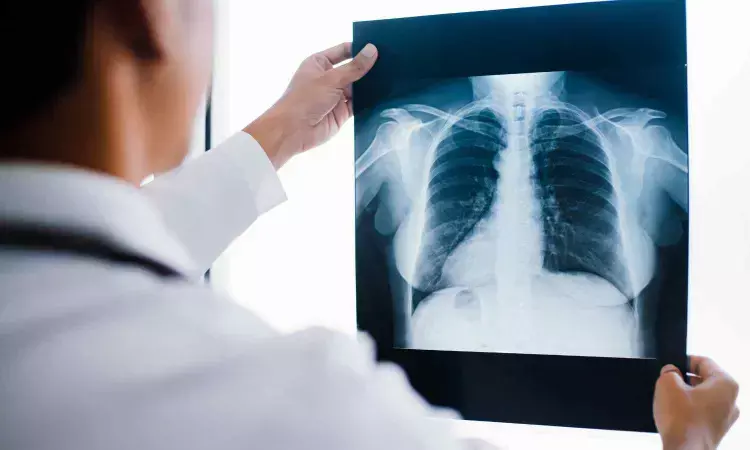- Home
- Medical news & Guidelines
- Anesthesiology
- Cardiology and CTVS
- Critical Care
- Dentistry
- Dermatology
- Diabetes and Endocrinology
- ENT
- Gastroenterology
- Medicine
- Nephrology
- Neurology
- Obstretics-Gynaecology
- Oncology
- Ophthalmology
- Orthopaedics
- Pediatrics-Neonatology
- Psychiatry
- Pulmonology
- Radiology
- Surgery
- Urology
- Laboratory Medicine
- Diet
- Nursing
- Paramedical
- Physiotherapy
- Health news
- Fact Check
- Bone Health Fact Check
- Brain Health Fact Check
- Cancer Related Fact Check
- Child Care Fact Check
- Dental and oral health fact check
- Diabetes and metabolic health fact check
- Diet and Nutrition Fact Check
- Eye and ENT Care Fact Check
- Fitness fact check
- Gut health fact check
- Heart health fact check
- Kidney health fact check
- Medical education fact check
- Men's health fact check
- Respiratory fact check
- Skin and hair care fact check
- Vaccine and Immunization fact check
- Women's health fact check
- AYUSH
- State News
- Andaman and Nicobar Islands
- Andhra Pradesh
- Arunachal Pradesh
- Assam
- Bihar
- Chandigarh
- Chattisgarh
- Dadra and Nagar Haveli
- Daman and Diu
- Delhi
- Goa
- Gujarat
- Haryana
- Himachal Pradesh
- Jammu & Kashmir
- Jharkhand
- Karnataka
- Kerala
- Ladakh
- Lakshadweep
- Madhya Pradesh
- Maharashtra
- Manipur
- Meghalaya
- Mizoram
- Nagaland
- Odisha
- Puducherry
- Punjab
- Rajasthan
- Sikkim
- Tamil Nadu
- Telangana
- Tripura
- Uttar Pradesh
- Uttrakhand
- West Bengal
- Medical Education
- Industry
Using Diaphragm Position on Chest Radiograph for Assessing Lung Volume in Infants not accurate and precise: JAMA

A new study published in the Journal of American Medical Association revealed that the use of diaphragm position on chest radiographs lacked the precision needed to accurately assess aerated lung volume and guide clinical decisions in infants in neonatal intensive care unit (NICU). Therefore it will be worthwhile to use a combination of clinical and diagnostic radiographic features to assess lung volume rather than diaphragm position alone.
Although it is standard procedure and advised by NICU guidelines, using chest radiographs to direct lung aeration during respiratory support in neonates has never been proven to be effective. Thus, this study was set to characterize the relationship between the infant's diaphragm position on a chest radiograph and the computed tomography (CT) measurement of aerated lung capacity.
The Royal Children's Hospital in Melbourne, Australia, was the site of this retrospective cross-sectional study. Infants without congenital lung pathology who had a chest CT scan within 30 days of delivery, from July 9, 2012, to December 31, 2022, were included. Analysis of the study's data took place between December 2022 and September 2023.
CT semiautomated tissue segmentation was used to quantify lung volume, and a consistent definition was used to establish diaphragm position. The measures from the chest radiograph were unknown to all of the investigators who were examining the CT scans, and vice versa. The distribution and accuracy of the total lung volume at each of the diaphragm positions (6th-11th posterior rib) were the main results.
A total of 218 newborns (mean [SD] age, 37.9 [1.9] weeks gestation at birth; 119 male [55%]; median [IQR] age, 11 [3-20] days) had their imaging data examined. A primary cardiac diagnosis was made for 132 (61%) of the infants, whose mean (SD) weight at scan was 3055 (584) g. The diaphragm location was represented by 6 to 11 posterior ribs. Lung volume and diaphragm position were only weakly correlated (Kendall τ = 0.23; 95% CI, 0.16–0.31).
The degree of consolidation (Kendall τ = 0.30; 95% CI, 0.21-0.38), apex-diaphragm distance (Kendall τ = 0.40; 95% CI, 0.28-0.51), hemithorax (left, Kendall τ = 0.25; 95% CI, 0.15-0.34; right, Kendall τ = 0.21; 95% CI, 0.10-0.31), and Hounsfield unit values (Kendall τ = −0.05; 95% CI, −0.15 to −0.06) all showed a similar weak association. Overall, in response to these findings, the diaphragm position as determined by the number of posterior ribs on a chest radiograph may not be accurate enough for practical use as a surrogate of lung volume, even though it has long been clinically accepted.
Source:
Dahm, S. I., Sett, A., Gunn, E. F., Ramanauskas, F., Hall, R., Stewart, D., Koeppenkastrop, S., McKenna, K., Gardiner, R. E., Rao, P., & Tingay, D. G. (2025). Diaphragm position on chest radiograph to estimate lung volume in neonates. JAMA Pediatrics. https://doi.org/10.1001/jamapediatrics.2025.2108
Neuroscience Masters graduate
Jacinthlyn Sylvia, a Neuroscience Master's graduate from Chennai has worked extensively in deciphering the neurobiology of cognition and motor control in aging. She also has spread-out exposure to Neurosurgery from her Bachelor’s. She is currently involved in active Neuro-Oncology research. She is an upcoming neuroscientist with a fiery passion for writing. Her news cover at Medical Dialogues feature recent discoveries and updates from the healthcare and biomedical research fields. She can be reached at editorial@medicaldialogues.in
Dr Kamal Kant Kohli-MBBS, DTCD- a chest specialist with more than 30 years of practice and a flair for writing clinical articles, Dr Kamal Kant Kohli joined Medical Dialogues as a Chief Editor of Medical News. Besides writing articles, as an editor, he proofreads and verifies all the medical content published on Medical Dialogues including those coming from journals, studies,medical conferences,guidelines etc. Email: drkohli@medicaldialogues.in. Contact no. 011-43720751


